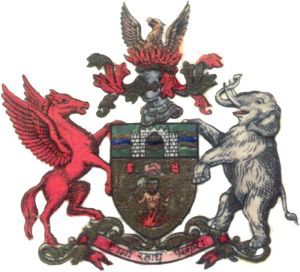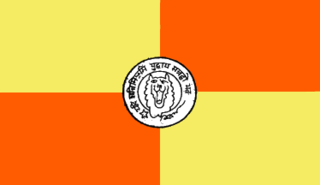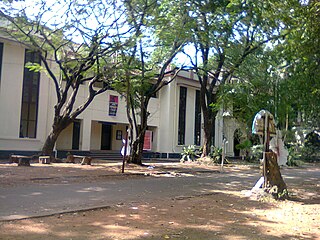
The Indian Rebellion of 1857 was a major uprising in India in 1857–58 against the rule of the British East India Company, which functioned as a sovereign power on behalf of the British Crown. The rebellion began on 10 May 1857 in the form of a mutiny of sepoys of the company's army in the garrison town of Meerut, 40 mi (64 km) northeast of Delhi. It then erupted into other mutinies and civilian rebellions chiefly in the upper Gangetic plain and central India, though incidents of revolt also occurred farther north and east. The rebellion posed a military threat to British power in that region, and was contained only with the rebels' defeat in Gwalior on 20 June 1858. On 1 November 1858, the British granted amnesty to all rebels not involved in murder, though they did not declare the hostilities to have formally ended until 8 July 1859.

Arrah is a city and a municipal corporation in Bhojpur district in the Indian state of Bihar. It is the headquarters of Bhojpur district, located near the confluence of the Ganges and Sone rivers, some 24 mi (39 km) from Danapur and 36 mi (58 km) from Patna.
Shahabad district or Arrah district, headquartered at Arrah was a Bhojpuri speaking district in western Bihar, India, making the western border of Bihar with Uttar Pradesh. In 1972, the district was split into two districts: Bhojpur and Rohtas. Kaimur District was carved out from Rohtas in 1991 and Buxar District from Bhojpur in 1992.

Bhojpur district is one of the 38 districts of the Indian state of Bihar. Arrah city is the administrative headquarters of this district. Bhojpur district came into existence in 1972. Earlier it was the part of Shahabad district. This district is named "Bhojpur" after great Parmara King Bhoja as most early settlers were Rajput rulers of Parmara dynasty then called as Ujjainiya.

Veer Kunwar Singh University was established on 22 October 1992 with its headquarters at Arrah, under the Bihar University Act 1976 [as amendment Act 9 of 1992]. It is named after Kunwar Singh, the well-known national hero and a distinguished freedom fighter of 1857.

Arrah Lok Sabha constituency is one of the 40 Lok Sabha (parliamentary) constituencies in Bihar, India. It is a part of the Bhojpur district and comprises seven Assembly constituencies: Sandesh, Barhara, Arrah, Agiaon (SC), Tarari, Jagdishpur and Shahpur.
Babu Amar Singh was a revolutionary in the Indian Rebellion of 1857 and the brother of Babu Kunwar Singh, the zamindar of Jagdishpur.

Jagdishpur is a nagar panchayat town of the district Bhojpur of the state of Bihar in eastern India. It was the capital of the eponymous Jagdishpur Raj ruled by Rajputs of the Ujjainiya clan. One of its rulers, Kunwar Singh, was a major figure in the Indian Rebellion of 1857, considered the leader of the rebellion in Bihar.

Ujjainiya is a clan of Rajputs found in Bihar and Purvanchal. They are originally an off-shoot of Paramara dynasty of Malwa. The Ujjainiya dynasty historically ruled over the parts of Bhojpuri region during the medieval era. They were mainly rulers and aristocrats holding major power of the region.
Baluahi is a village in Bhojpur district in the state of Bihar, India, located 25 km from Arrah and 1 km from Jagdispur.It has total 124 families residing. Baluahi has population of 632 as per government records.
Purbiya was a common term used in medieval India for Rajput and Brahmin mercenaries and soldiers from the eastern Gangetic Plain - areas corresponding to present-day western Bihar and eastern Uttar Pradesh. The Purbiyas played a significant role in the militaries of various principalities in Western India including the Marwar army as well at the Gujarat Sultanate and Malwa Sultanate.

The siege of Arrah took place during the Indian Mutiny. It was the eight-day defence of a fortified outbuilding, occupied by a combination of 18 civilians and 50 members of the Bengal Military Police Battalion, against 2,500 to 3,000 mutinying Bengal Native Infantry sepoys from three regiments and an estimated 8,000 men from irregular forces commanded by Kunwar Singh, the local zamindar or chieftain who controlled the Jagdishpur estate.
Hare Krishna Singh (1826-1858) was the commander-in-chief of Kunwar Singh's forces in the Indian Rebellion of 1857 and also served under his brother Babu Amar Singh.
Pandey Ganpat Rai was a revolutionary and rebel leader in the Indian Rebellion of 1857 and a chieftain in Lohardaga district of Bihar.
Deo Raj, was a zamindari (estate) situated in what is now Aurangabad district of Bihar. The Deo Raj family were notable for being the protectors of Deo Sun shrine.

The Jagdishpur Raj was a feudatory zamindari ruled by a cadet branch of the Ujjainiya dynasty. It was situated in modern-day Jagdishpur, in the erstwhile Shahabad district of Bihar. The capital of the principality was the town of Jagdishpur by which the principality derived its name.

Maharaja College is a constituent college of Veer Kunwar Singh University, Arrah in the Bihar State of India. It was founded on 13 September 1954. It is one of the oldest co-educational institution of south-west Bihar. Originally it was a part of Magadh University but in 1992 after the establishment of Veer Kunwar Singh University it became the part of it.
Veer Kunwar Singh Museum is museum in Jagdishpur near Arrah in Bhojpur district of Bihar. It is named after freedom fighter Kunwar Singh who played an important role in the Indian Rebellion of 1857. It has a good collection of artifacts related to India's struggle for independence.

Dulaur is a small village in Jagdishpur block of Bhojpur district in Bihar, India. As of 2011, its population was 345, in 47 households. Located 2 km east of Jagdishpur, Dulaur is known as having been the site of the final battle between Kunwar Singh and the British army during the Indian Rebellion of 1857.













